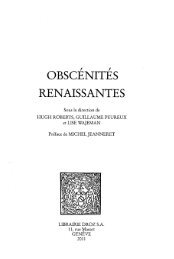Download (3398Kb) - ePrints Soton - University of Southampton
Download (3398Kb) - ePrints Soton - University of Southampton
Download (3398Kb) - ePrints Soton - University of Southampton
You also want an ePaper? Increase the reach of your titles
YUMPU automatically turns print PDFs into web optimized ePapers that Google loves.
Data on maximum body size, maximum egg size and maximum Gonad Index,<br />
were plotted against depth <strong>of</strong> maximum abundance for all the species, and the<br />
resulting graphs were investigated in order to find possible patterns or relations<br />
between the reproductive features. The degree to which the variables were related was<br />
tested by using the Spearman Rank<br />
Correlation Coefficient (Rs) and the results discussed (Fowler et al., 2000). A nonparametric<br />
test was preferred because the data were presented as actual observations,<br />
observations converted to ranks and indices; furthermore a parametric test would<br />
require the data to be normally distributed and to have homogeneous variances<br />
(Fowler et al., 2000).<br />
Although the relatively low number <strong>of</strong> data would suggest that the data set is<br />
not suitable for a multivariate analysis, this analysis was performed with the PRIMER<br />
(Plymouth Routines in Multivariate Ecological Research) Version 5 programme<br />
(Clarke and Warwick, 2001) to investigate if a pattern could be observed.<br />
Data on adult size, egg size and Gonad Index were analyzed together by the<br />
Normalized Euclidean distance measure applied to all the asteroid species.<br />
Hierarchical clustering with group-averaged linking and non-metric multidimensional<br />
scaling using all resulting similarity matrices was performed (Clarke and<br />
Warwick, 2001). The groupings identified by both cluster analysis and the MDS plots<br />
were investigated using the available data on the species regarding reproductive<br />
features determined in this study and depth related distribution in the NE Atlantic<br />
established by Howell et al. 2002.<br />
4.3- Results<br />
The Spearman’s correlation coefficient showed that no correlation exists<br />
between depth (over the entire range) and body size (as R) <strong>of</strong> the species (Rs= 0.056,<br />
75
















